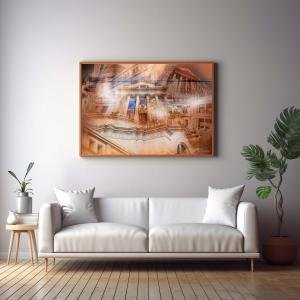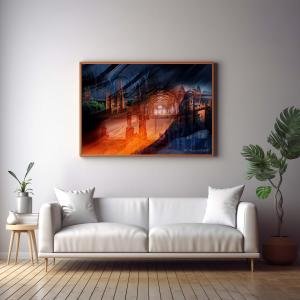Wings of Discovery: From Earth to the Cosmos
The Smithsonian National Air and Space Museum stands as a testament to humankind’s unquenchable thirst for knowledge and exploration. I chose to highlight this iconic institution because it represents both the past and future of our journey through the skies and beyond. This artwork is a reflection on how aviation and space exploration have shaped not only our world but our collective imagination.
Please see Below for Details…
Hotline Order:
Mon - Fri: 07AM - 06PM
404-872-4663
At the center of this piece is the Space Shuttle Exhibit , representing humanity’s leap into the unknown, reaching beyond the confines of Earth to explore the infinite mysteries of the cosmos. The planetary models evoke a sense of awe, reminding us of the vastness of the universe and our small but significant place within it. I included these elements to express the wonder and ambition that drive us to look upward, always seeking answers among the stars.
The Curtiss P-40 Kittyhawk , a fighter plane from World War II, symbolizes the courage and resilience of those who fought in the air. Its inclusion reflects a time when the skies became battlefields, and technology was rapidly advancing to meet the demands of a world at war. The Westland Lysander , known for its reconnaissance missions and clandestine operations, adds a layer of intrigue and heroism to the narrative. Its role in covert missions during World War II adds a sense of danger and mystery to the piece, a nod to the daring feats that shaped history from behind enemy lines.
In contrast, the Sopwith Camel F.1 , a World War I fighter plane, takes us back to the early days of aviation combat. Its inclusion is a reminder of the infancy of flight, a time when daring pilots pushed the limits of human capability and technology in the skies above Europe. The Sopwith Camel was one of the most successful planes of its time, and its presence in this artwork speaks to the ingenuity and bravery that marked the beginning of modern aviation.
The architectural structure of the museum, with its sleek geometric panels and reflective surfaces, serves as a visual metaphor for the intersection of the past and future. I used these shapes to convey a sense of movement and progress, as though the viewer is being propelled forward through history. The clean lines and metallic tones suggest innovation and forward-thinking, mirroring the cutting-edge technology on display within the museum's walls.
Visitors , seen in shadow, provide a sense of scale and wonder, reinforcing the idea that this space is not just about objects, but about people—those who built, flew, and were inspired by these machines. As they walk through the museum, they become part of the story, a reminder that history is not static but something we all participate in.
The colors in this piece, primarily blue and orange , were chosen to evoke specific emotional responses. Blue is often associated with exploration, the sky, and the vastness of space. It symbolizes calm, depth, and introspection, as well as the infinite possibilities that lie ahead in both aviation and space exploration. Orange , on the other hand, represents energy, warmth, and the drive for innovation. It is a color of passion and ambition, reflecting the fiery spirit of those who dared to venture into the skies and beyond.
The blending of these two colors, much like the blending of history and modernity within the museum, creates a visual harmony that suggests movement and progression. Together, they evoke a sense of wonder and curiosity, inviting the viewer to explore the exhibits and imagine the stories behind each aircraft and spacecraft.
Add your review
Your email address will not be published. Required fields are marked *
Please login to write review!
Looks like there are no reviews yet.








